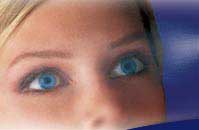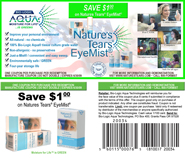
Eye Strain and Computers
Dry Eye and Healthy Computer Use
Larry Wan, DO, (San Jose, CA).
Larry Wan has been an optometrist for 25 years. His office is in the heart of Silicon Valley, in California, so he has a special interest in vision and computers. Sitting at a computer for more than 30 minutes can contribute to eye strain, dry eye and eye disease.
Most people blink 30 to 40 times a minute, or 10,000 times a day. During intense computer use the blink rate can drop to as little as five times a minute. Each blink replenishes the water in the eye's tear film and prolonged periods of insufficient blinking can cause tear film dehydration.
Add a dry climate (such as is found in Arizona), which also causes dry eye, and the problem of computer dry eye becomes even worse. Even without computers, indoor conditions can be worse on the eyes than outdoor dryness. In an effort to make building more energy efficient, designers have made them less livable and natural. Forced-air heating and cooling, and insulated walls and windows are extremely dehydrating. Airliners are even worse for your eyes because of low humidity, re-circulated air and crowding.
We need computers but we must also learn to naturally live with them without endangering our health.
Computers are normally a different distance from the eyes than books, so glasses might need to be changed to accommodate this. Also, a computer image consists of thousands of dots (pixels), to which the eye must constantly adjust to keep the images in focus. In a book, the eyes mostly look at sharp, black and white lines. As a result, when working on a computer, the ciliary muscle in the eye that keeps things in focus work constantly, which can be very tiring. While reading, they work far less.
To prevent computer eye strain and computer caused dry eye and dehydration disease, Dr. Wan suggests good lighting, correct eyeglasses, good posture (to prevent shoulder and headaches), good natural lighting (not fluorescent), minimized glare, and positioning yourself to look down on the screen. The screen should be slightly more than an arm's length away. He recommends a flat panel rather than a tube screen, sitting high, looking down so your eyes don't open as wide, and drinking sufficient water each day. .
Dr. Wan is an advocate of the "20/20"rule: Take a 20 second break every 20 minutes in which you look away from the screen.
And don't forget to educate your children about correct computer use. It is also important to configure your computers so that children can use them comfortably, especially with respect to the "arm's length" rule.
Dr. Wan's website is www.stanleyeyecare.com.
Sharon Kleyne's evaluation: I had Dr. Wan as a guest on the Sharon Kleyne Hour - Power of Water because, like everyone else, I am concerned about the increasing use of computers at an increasingly younger age and the effect on eye health. Computer use is one reason for the alarming worldwide increase in dry eye syndrome. Not only is it important to use computers wisely, it is also important to take care of your eye health and drink sufficient water each day.
CONTACT:
Bio-Logic Aqua Research - Rogue Media Division.1-800-FOR-MIST (367-6478)
RogueMedia@biologicaquaresearch.com
www.sharonkleynehour.com
whatistheeye.wordpress.com
www.biologicqua.com









